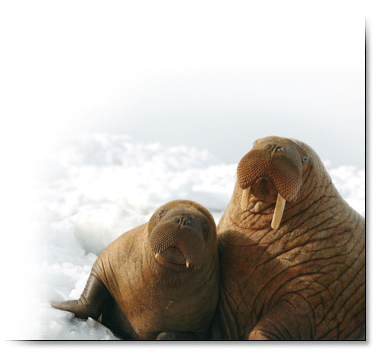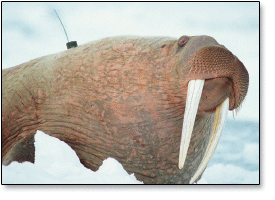 |
| Mother and juvenile Pacific Walrus from http://pubs.usgs.gov/fs/2008/3041/ |
It's about to be pretty important because the sea ice where they rest between trips to feed doesn't last into the summer anymore. I spent some time today perusing USGS data online about walruses on the coast of Alaska and Russia in the Bering Sea. Here's the sort of introductory article.
Females and babies used to hang out on the ice during the summer while the offensively equipped males spent more time on land. The hotter summers now mean they all have to go to shore. I imagine there are other implications, from vulnerability to predation to increased spread of disease (I'm totally brainstorming. No data on this. I'm just figuring ice washes itself.) I don't even know how they might interfere with humans directly. It's not like there are a lot of hotels on that shoreline so maybe it's fine for now. After all Alaska is not Florida. If some smelly mammals set up house on the beach in Destin there would be some kind of uproar for sure. People hate smelly animals on their beach. And I am assured that marine mammals on the land are something you want to observe from upwind.
 |
| Walrus with a radio tag |
So basically the oil companies have to pay biologists to quantify the current situation so that when they wreck it they know how much to pay for it. It's a pretty warped system. I used to be part of it back in Florida. Big developer would be required by the Department of Environmental Protection to have water testing done to be sure they weren't making things worse in the wetlands by building a resort. Of course the level of testing required to get a before and after comparison that is remotely valid is a full time job for three people. So instead they have three people work on it once every three months for a single day, just some joke of a thing that was the equivalent of a feeble jobs program for people in the private science and engineering business. The price of the permit wasn't nearly enough to pay the salary of the people who had to process the paperwork and the developer was probably exempt of all taxes. I pretty heartily disapproved of the whole thing actually.
Just the same I think it's totally cool that there's a guy on a research vessel with a crossbow shooting radio transmitters into the tough old skin on the back of a walrus. Radio transmitters picked up by the polar orbiting Argos satellite, courtesy of France. Then he has to analyze data with error bars so big they have to throw some away because it's physically implausible. And I think it's cool that there are people designing those radio transmitters.
But I know the transmitter designer was probably just a consultant hired for a month or so of work and then they didn't need them anymore. And it probably is less than 20 people total that work with this walrus data every day. I'm just guessing there are more oil company lawyers involved in trying to get this lease deal through than there are scientists up there quantifying the territory of the walruses. That makes me anxious. Walruses are way more interesting to me than oil.
Walruses feed in a unique way for marine mammals. They like to stay on the continental shelf and dive down to the bottom and feel around with their whiskers for shellfish then they suck the meat out. Just suck it right out. I can't find it online but I read in a book that when Alaska native hunters kill a walrus the first thing they do is get the stomach out and wash off all the clams in there and eat those first. They can get 1500 perfectly shucked clams out of one walrus. I guess walruses don't chew their food. I imagine they just shoot straight down their gullet.
The biologists haven't quantified what overall effect the walrus have on the ecosystem of the ocean floor. They imagine that stirring and digging with their tusks isn't trivial. It's a hard thing to do, quantifying those effects. Very hard. I bet the walrus guy that shoots them with the radio transmitter crossbow has a feeling about it. If he's lucky he'll get some money and equipment to collect core samples so he can compare them with new ones after everything is different in a few years. Before and after comparisons are about the best we get when there is no money for science. I hope they do all of it. Record the sounds, pictures, chemistry, and the smell if they can figure out how. Mainly I hope that same guy can keep a job in walrus science because if all those people get unemployed that remember what it was like before the summer ice was gone then there will be nobody to see the difference. Nobody to make a judgement call when there isn't anything compelling for bureaucrats to go by. Apparently the walrus guy is Chad Jay, employed by the USGS. Please, USA, collect enough taxes to keep him employed. And if you can scare up a few extra dollars I could edit his abtracts for him. This is unneccessarily hard to read: "From the current observation period to the end of century, the greatest change in walrus outcome probabilities was a progressive decrease in the outcome state of robust and a concomitant increase in the outcome state of vulnerable." I'm not crazy about his mathematical-model based conclusion. He says the model isn't very good because there are so many mechanisms affecting the walruses that they haven't quantified. I don't know what I want instead. I just think there needs to to be something between models based on poorly understood mechanisms affecting walruses survival and stuff like this highly anthropomorphized National Geographic video. Maybe some kind of fuzzy logic that can combine the data they have with some biofeedback machine that measures the level of anxiety in the walrus experts.


No comments:
Post a Comment